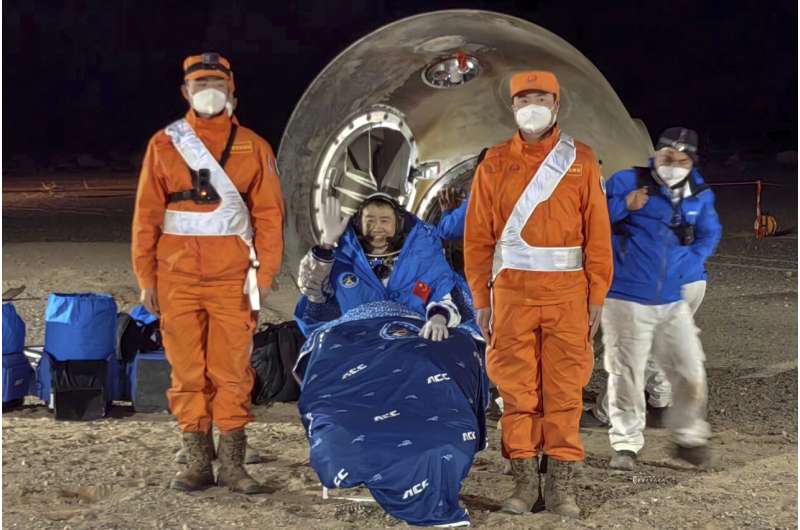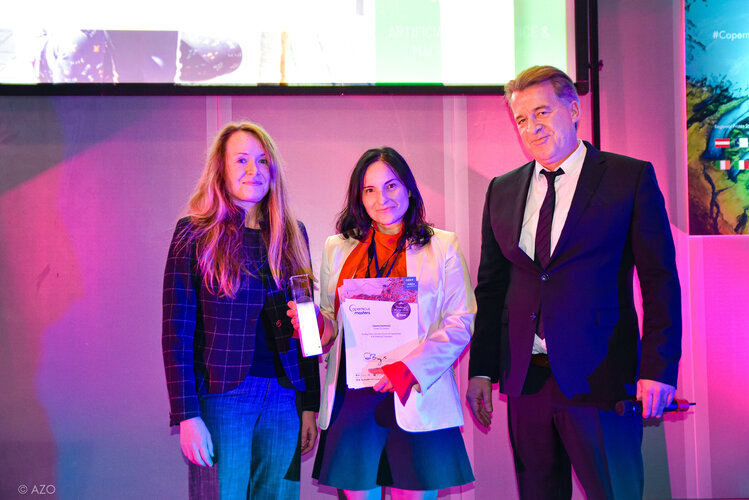
Copernical Team
China astronauts return from Tiangong space station
 Three Chinese astronauts safely returned to Earth on Sunday after six months aboard the Tiangong space station, state media quoted the country's space agency as saying, with their mission deemed a "complete success."
The team, which had been aboard the station since early June, touched down at the Dongfeng landing site in Inner Mongolia at 8:09 pm Beijing time (1209 GMT), Xinhua news agency
Three Chinese astronauts safely returned to Earth on Sunday after six months aboard the Tiangong space station, state media quoted the country's space agency as saying, with their mission deemed a "complete success."
The team, which had been aboard the station since early June, touched down at the Dongfeng landing site in Inner Mongolia at 8:09 pm Beijing time (1209 GMT), Xinhua news agency AST SpaceMobile closes $75M funding round
 AST SpaceMobile, Inc. (NASDAQ: ASTS) has closed of its offering of 13,636,364 shares of Class A Common Stock raising gross proceeds of $75.0 million. B. Riley Securities ("B. Riley") was the sole book-running manager of the offering. The Company has also granted B. Riley a 30-day option to purchase an additional 2,045,454 shares to cover over-allotments, if any, which would raise an additional $
AST SpaceMobile, Inc. (NASDAQ: ASTS) has closed of its offering of 13,636,364 shares of Class A Common Stock raising gross proceeds of $75.0 million. B. Riley Securities ("B. Riley") was the sole book-running manager of the offering. The Company has also granted B. Riley a 30-day option to purchase an additional 2,045,454 shares to cover over-allotments, if any, which would raise an additional $ SpaceX gets federal approval to launch 7,500 communication satellites
 SpaceX, the American aerospace manufacturing company owned by billionaire Elon Musk, has received federal approval to launch 7,500 satellites in an operation that would expand the company's Starlink internet services around the world.
Thursday's decision by the Federal Communications Commission, although not everything SpaceX wanted, was seen as a monumental victory for the company as i
SpaceX, the American aerospace manufacturing company owned by billionaire Elon Musk, has received federal approval to launch 7,500 satellites in an operation that would expand the company's Starlink internet services around the world.
Thursday's decision by the Federal Communications Commission, although not everything SpaceX wanted, was seen as a monumental victory for the company as i Orion set for final Lunar flyby
 Orion performed the second return trajectory correction burn on Sunday, Dec. 4, at 10:43 a.m. CST, using the auxiliary thrusters and increasing the spacecraft's velocity by 1.16 mph (1.71 feet per second).
Shortly after acquiring signal with the Deep Space Network's Canberra ground station at 12:41 a.m. CST, Orion experienced an issue with a power conditioning distribution unit (PCDU), in
Orion performed the second return trajectory correction burn on Sunday, Dec. 4, at 10:43 a.m. CST, using the auxiliary thrusters and increasing the spacecraft's velocity by 1.16 mph (1.71 feet per second).
Shortly after acquiring signal with the Deep Space Network's Canberra ground station at 12:41 a.m. CST, Orion experienced an issue with a power conditioning distribution unit (PCDU), in Australia starts building 'momentous' radio telescope

Australia on Monday started building a vast network of antennas in the Outback, its section of what planners say will eventually become one of the most powerful radio telescopes in the world.
When complete, the antennas in Australia and a network of dishes in South Africa will form the Square Kilometer Array (SKA), a massive instrument that will aim to untangle mysteries about the creation of stars, galaxies and extraterrestrial life.
The idea for the telescope was first conceived in the early 1990s, but the project was plagued by delays, funding issues and diplomatic jockeying.
Three Chinese astronauts return to Earth after 6-month mission

The world finally has its first 'parastronaut'. Can we expect anyone to be able to go to space one day?

The European Space Agency made history last week with the announcement of the first "parastronaut," 41-year-old UK citizen John McFall.
He is the first candidate selected for the Parastronaut Feasibility project, described by ESA as a "serious, dedicated and honest attempt to clear the path to space for a professional astronaut with a physical disability."
McFall, a former Paralympic sprinter, had his right leg amputated after a motorcycle accident at age 19.
Most of us are familiar with images of grueling astronaut selection tests and training from movies such as The Right Stuff. ESA seeks to answer the practical question of what changes to training and equipment need to be made for a physically disabled person to travel to space.
How are astronauts selected?
NASA first selected astronauts, the Mercury Seven, in 1959.
European Service Module, Orion, Moon, Earth
 Image:
European Service Module, Orion, Moon, Earth
Image:
European Service Module, Orion, Moon, Earth Week in images: 28 November - 02 December 2022

Week in images: 28 November - 02 December 2022
Discover our week through the lens
Green City Makers wins top prize at Copernicus Masters

Green City Makers wins top prize at Copernicus Masters
